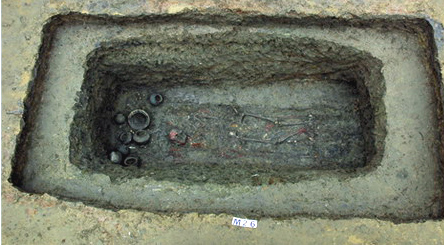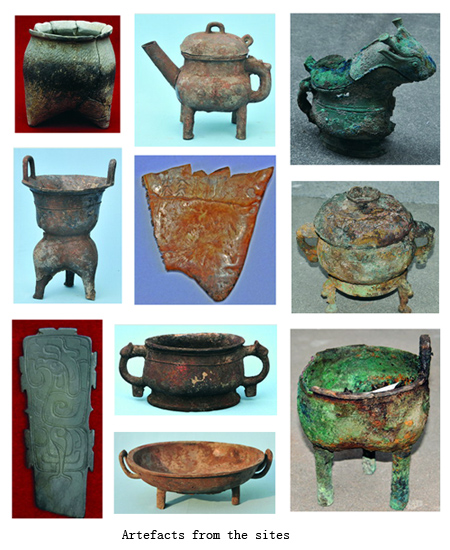The Chenzhuangcun City Site of the Western Zhou Dynasty

The Chenjiacun City site is located to the southeast of the synonymous village in Huagou Township, Gaoqing County, Shandong Province, altogether 80,000-90,000 sqm. From October of 2008 to November of 2009, the Shandong Provincial Institute of Cultural Heritage and Archaeology surveyed and excavated this city. Altogether it exposed an area of 6,500sqm, revealing nearly a thousand trashpits as well rammed-earth palace foundations, dwellings, roads, kilns, wells, and tombs as well as a sizeable ensemble of pottery, stone, bone, and shell artifacts as well as bronze and jade objects.

An important discovery of this excavation is of a city site of the Western Zhou dynasty. Roughly square in plan, it is 200m long and 190m wide, making a dimension of nearly 40,000sqm. The eastern and northern walls of this city are well preserved, at heights of 0.5-1.2m. The western wall only preserves the middle section, at heights of around 0.4m; the southern wall is razed to the foundation level. The walls are 5m wide at the top and 9-10m at the bottom. They are all built of rammed earth with distinct rammer imprints. The city has a moat of 20-25m wide and 2-3m deep. A gate sits at the middle of the southern wall, leading to a thoroughfare of 20-25m wide into the city. The gate, however, is thoroughly ruined. No gate has been found in the other three walls. The city can be dated to the Early and Middle Western Zhou, the first such site of this period ever found in northern Shandong.

Another important discovery is of a rammed-earth foundation. Circular in shape, it is 0.7-0.8m high and 5m in diameter, or roughly 20sqm in dimension. The foundation consists of, from innermost to outermost, a circular, a square, a rectangular, and a circular ring. It is tempting to link this foundation with ritual activities. To the northeast and north of this structure two horse pits are found. One pit accommodates six horses in two rows, the other two. Except for horse skeletons, however, no harnessing parts or ornament has been found in these pits.

In addition, a cemetery of the Western Zhou dynasty is found in the southeast of the city. Seven tombs are opened, and they are 3.5-5m long, 2.5-3.5m wide, and 5-8m deep. They are furnished with a chamber, a coffin, and a head box. The largest tomb among them is No.27, with a size of 6m long, 3.7m wide, and 8.2m deep. The head box contains pottery wares and bronze ritual vessels, including ding-tripods, gui-tureens, a gu-beaker, a jue-drinker, a yan-steamer, a zun-jar, a you-jug, a he-bottle, and a pan, as well as jades and cowries shells. A number of bronze vessels are also found in Tomb No.18. The bronze ding-tripod, gui-tureen, gu-container, yan-steamer, and you-jug are inscribed with “Feng pan zuo wenzujia qigong zunyi (Pan of Feng made ritual vessel in honor of Ancestor Wen Jia of Lord Qi.” The phrase “Lord Qi” is the first one of this kind ever found in Shandong Province. An oracle bone fragment of the Western Zhou dynasty is also the initial discovery of this kind. (Translated by Zhang Liangren)

